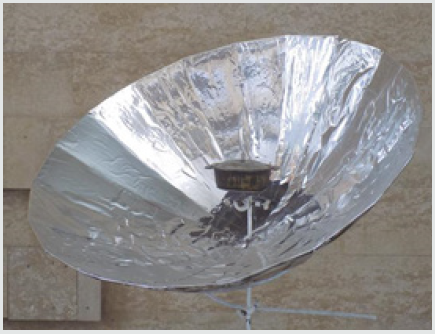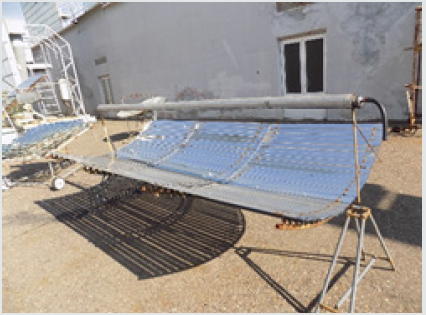
Lupine Publishers Group
Lupine Publishers
Menu
ISSN: 2637-4579
Research Article(ISSN: 2637-4579) 
Sample Solar Concentrators Volume 3 - Issue 4
Yuldash Sobirov1,4*, Sharif Kholov2, Sirozhiddin Makhmudov3 and Nilufar Qarshiyeva4
- 1Laboratory of Big Solar Installations, Institute of Materials Science Scientific Production Association “Physics-Sun” Academy of Sciences Republic of Uzbekistan, Uzbekistan
- 2Junior Researcher, Institute of Materials Science Scientific Production Association “Physics-Sun” Academy of Sciences Republic of Uzbekistan, Uzbekistan
- 3Doctoral student of Tashkent State Technical University named after Islam Karimov, Uzbekistan
- 4Deportment of Alternative Energy Sources, Tashkent State Technical University named after Islam Karimov, Uzbekistan
Received: September 12, 2019; Published: September 19, 2019
*Corresponding author: Yuldash Sobirov, Deportment of Alternative Energy Sources, Laboratory of Big Solar Installations, Institute of Materials Science Scientific Production Association “Physics-Sun” Academy of Sciences Republic of Uzbekistan, Parkent, Uzbekistan
DOI: 10.32474/OAJBEB.2019.03.000166
Abstract
This paper presents the experience in the development, creation and operation of solar concentrating plants for the exploitation of people in rural areas. Attention is provided by the state for the development of solar energy in Uzbekistan. The analysis of the effectiveness of the work of solar kitchens of various types in the conditions of Uzbekistan. The paper discusses the beneficial effects of these facilities to the environment, the conservation of non-renewable energy sources: coal, oil, gas. And also shows the results of measuring the energy characteristics, shows the temperature distribution on the visible surface of the kettle located in the fox chamber. At the same time, the remote method of measuring the temperature field using an FLIR E 8 infrared camera, which allows you to take a multispectral image (MSX) with a resolution of 76800 (320 x 240) pixels, is used to easily interpret the image, adding features of the visual spectrum in the infrared range.
Keywords: Paraboloid Concentrator; Radiant Flux; Solar Kitchen; Thermal Imager; Temperature Field; Mirror Surface
Introduction
One of the practical challenges facing the science of our time is the development of technologies for waste disposal along with the rational use of natural resources. In this regard, the Government of Uzbekistan adopted a series of resolutions to ensure an optimistic environment and the rational use of natural resources in order to ensure environmental sustainability in the sectors of the economy. For example, laws were passed by the Cabinet of Ministers on May 27, 2013 No. 142, May 21, 2019, the Law of the Republic of Uzbekistan No. URQ-539. One of the most important tasks not only for the energy sector, but also for the economy in the republic is the rational and effective use of the existing fuel and energy potential, which leads to the adoption of measures for energy saving, the introduction of modern energy equipment and the latest technologies in this field. Uzbekistan today has a significant potential of scientific and technical personnel and accumulated a large amount of design and technological developments in the design and use of solar power plants [1].
According to a study conducted by the Environmental Protection Agency, the issue of providing the population with electricity is the third after industrial and transport consumption. This means that if alternative sources of energy were used in cooking or home cooking, the term “demand balance” would be forgotten in the future.
Suncentre Flow Concentrators
There are various types of equipment for collecting solar radiation, including optical furnaces, such as a parabolic concentrator, which most effectively concentrates the solar radiant flux. Parabolic concentrators are not only efficient in heat exchange but can also be used as a solar kitchen. Solar kitchens in the form of a parabola are the best solutions to many problems faced by developing countries, such as overcoming excessive problems with electricity, such as energy consumption, unemployment, the movement of people from the village to the cities and other social problems. Solar kitchen in the form of a parabola, despite a number of advantages, have some difficulties. These difficulties include low utilization, complexity, and low social acceptance. It is extremely important to increase the efficiency of solar installations and eliminate the problems faced by the proliferation of solar furnaces.
The use of solar panels is a solution to the problems arising from the use of wood and electricity, which is a way of life and the means necessary for production. More than two billion people around the world are used as fuel for cooking or heating. If we look at this situation with an African example, then fuel consumption in southern Africa is 840,000 m3 per year. In addition, some of those used as wood fuel face wood shortage problems. But they live in climatic zones that are easy to use for solar panels. According to surveys of people using firewood for heating, many women are forced to cross several kilometers to collect firewood and face various dangerous risks. Needless to say, people in rural areas need wood, which leads to migration to the city and a lack of forests.
The use of solar furnaces is limited for some reason, because the sun cannot be reached 24 hours a day, in the absence of the sun or on cloudy days, solar furnaces cannot function fully or operate at full speed. The results obtained on solar furnaces were identified as an innovation in the limitations and barriers to the development of thermal energy.
Researcher Yettou [2] identified problems such as the recognition of a solar furnace, the complexity of the design, the time spent on heat generation, the inability to control the air or the complexity and effectiveness of the dimensions of the furnace, the influence of solar radiation. All these problems prevent the solar kitchen from competing with other cooking facilities. It is important to develop and develop highly efficient solar furnaces that can produce simple, low-volume solar rays that can be converted into heat, the energy transferred from the sun. In such sunny kitchens you can boil water, cook eggs, and cook various dishes. A solar kitchen with a parabolic concentrator with a diameter of 1 m is equal to an electric cooker with a capacity of 450-500 W, boiling 6-7 liters of water per hour. In such a sunny kitchen you can cook writing from 4 to 5 people. This device for 1.5-2 years saves more than 1000 kWh of electricity per year [3].
Usually for scientific and technical research solar concentrators with a diameter of 1 to 3 m are used. In many cases, these concentrates are made of monolithic mirrors 10-20 mm thick, and surface defects are about 5-8 angular minutes. The cost of such hubs is expensive. In households, farmers can use such concentrators for boiling water and cooking, but they can be made from sheet metal and can be coated with a reflective film. UNICEF confirms that in developing countries 60% of the rural population and 23% of the urban population do not have safe drinking water. If it heats water to a temperature of 65°C, then all germs, viruses and parasites can be destroyed. This function is easy to perform using simple solar kitchens [4]. People believe that solar kitchens cannot boil water to a safe level, they think that they need to be heated at higher temperatures.
Dr. Robert Metcalfe said that when cholera was spreading in Peru, the Ministry of Health called on all people to drink water for 10 minutes. This accounted for 29% of poor households. This amount of heat is much higher than the amount of heat needed to kill infectious germs. Young people from the Institute of Materials Science of the Research and Production Association “Physics-Sun” took the initiative: “The creation by every young scientist of a small, light, cheap and convenient hub is a solar kitchen. Our young scientists are actively participating in this initiative: Rajamatov Otabek, Pulatov Dilshod, Ernazarov Fayzullo. The following photos show several small sunny kitchens (Figure 1).
Figure 1: Paraboloid concentrator formed from a thin layer of self-adhesive reflective film. Paraboloid concentrator formed from a thin layer of self-adhesive reflective film.

We have developed a multifaceting helio kitchen. The solar kitchen is designed for cooking and hot water in the field, during leisure and various expeditions. The installation is equipped with a multi-mirror solar energy concentrator, a thrust-turning mechanism with an azimuthally zenithal orientation system on the Sun, and a 15mm diameter pipe for installing receivers: boilers, teapots, etc. Boiling time of 1liter of water on a sunny day is 10-15minutes. (depends on direct solar radiation flux). The solar kitchen consists of 100 mirrors with dimensions 10x10x0.6 cm with a reflection coefficient of 70% with rear aluminum reflection. The mirror is mounted on the frame with the help of a “Г” shaped plate, one end of which is glued with epoxy glue on the back surface of the mirror.
The vertical and horizontal axes of the installation allow the installation to be oriented in azimuthal - zenithal directions. The orientation of the installation on the Sun is carried out manually, which simplifies installation and there is no need to use electrical energy to power the tracking system. Separate mirrors are attached to the hub frame using M10 bolts, which simplifies the process of assembling, mounting and adjusting the installation. The kitchen frame is assembled from 10 pipes with a diameter of 15 mm and 10 plates with a hole for installing mirrors are welded on each tube (Figure 2).
Figure 2: General view of the solar kitchen. 1-rack, 2-vertical axis of rotation, 3-horizontal axis of rotation, 4-frame for installation of mirrors, 5-mirrors, 6-holder.
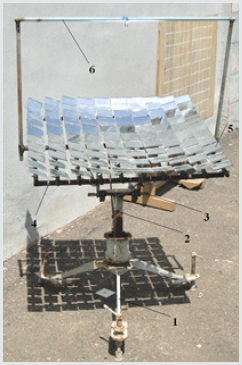
The adjustment of the installation is made according to the “image overlay” method [5]. In this case, the surfaces of the individual mirrors were covered with a dense cloth and only the adjusted individual mirror, the facet, was left open. The sunspot “bunny” from each adjusted facet was directed to a screen installed in the focal zone of the solar kitchen. In the future, the receiving surface of the kettle (boiler), etc. will be located in this area.
The performance of the solar kitchen depends on the reflecting surface — the power of the installation, on the optical characteristics of the reflecting surface, on the accuracy of the direction to the Sun, on the direct solar radiation flux [6].
The useful heat produced by the solar kitchen throughout the year can be calculated by the formula:
where η= 0.4 - thermal efficiency heat sink - boiler; kettle. r is the reflection coefficient of the mirror surface of the facets (r = 70%); F is the sectional area of the reflector (F = 1m2); S is the average value of the annual amount of direct radiation falling on a perpendicular surface on cloudless days [7].
Figure 3: Temperature field on the teapot located in the focal zone of the multi-facet helio kitchen.
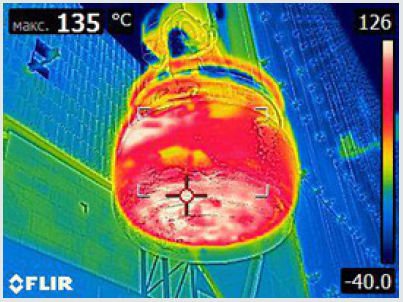
Measuring direct daily, monthly and annual sums of direct solar radiation and substituting them into formula we obtain the average annual heat output of the solar kitchen:
Q=0.4*0.7*1*S=0.28*10118.9=2833.292 MJ / year
where S = 10118.9 MJ/m2 year from the literature [6,7].
The temperature field in the focal zone of the solar kitchen is measured using an FLIR E-8 infrared camera [8] (Figures 3-6).
Figure 4: Temperature field on the teapot located in the focal zone of the multi-facet helio kitchen.
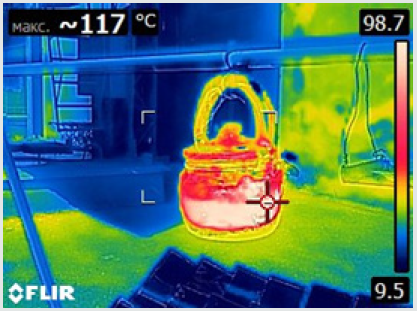
Conclusion
These lightweight, cheap, convenient solar concentrators allow you to save stocks of non-renewable types of energy: oil, gas, coal, etc. Small, home-made solar kitchens allow the environment to be safe, to heat and boil water, to cook food without breaking the tree, without collecting firewood, without burning a fire.
Acknowledgement
I express my gratitude to the first deputy director of the Institute of Materials Science, Odilkhuzha Raimkhuzhaevich Parpiev for the support and inspiration of the young scientists of our institute.
Acknowledgement
Authors gratefully acknowledged to Trivedi Global, Inc., Trivedi Science, and Trivedi Master Wellness for their support. In addition, authors are thankful for the support of Dabur Research Foundation for conducting this study.
References
- Decree of the President of the Republic of Uzbekistan (2013) On measures for the further development of alternative energy sources.
- Yettou F, Gama A, Azoui B, Malek A, Panwar NL (2019) Experimental investigation and thermal modelling of box and parabolic type solar cookers for temperature mapping. Journal of Thermal Analysis and Calorimetry 136(3): 1347-1364.
- Robert TD (2015) А stand-alone parabolic dish solar cooker for African conditions. Stellenbosch University, South Africa.
- http://solarcooking.org/pasteuriization/solarwat.html.
- Zahidov RA (1986) Mirror systems of radiant energy concentration. Tashkent, Uzbekistan, pp. 174.
- Alimov AK, Usmanov MU, Abduazizov A (1966) The economic effect of using helio kitchens of mass The USSR Climate Handbook, Solar radiation, radiation balance and sunshine.
Editorial Manager:
Email:
biomedicalengineering@lupinepublishers.com

Top Editors
-

Mark E Smith
Bio chemistry
University of Texas Medical Branch, USA -

Lawrence A Presley
Department of Criminal Justice
Liberty University, USA -

Thomas W Miller
Department of Psychiatry
University of Kentucky, USA -

Gjumrakch Aliev
Department of Medicine
Gally International Biomedical Research & Consulting LLC, USA -

Christopher Bryant
Department of Urbanisation and Agricultural
Montreal university, USA -

Robert William Frare
Oral & Maxillofacial Pathology
New York University, USA -

Rudolph Modesto Navari
Gastroenterology and Hepatology
University of Alabama, UK -

Andrew Hague
Department of Medicine
Universities of Bradford, UK -

George Gregory Buttigieg
Maltese College of Obstetrics and Gynaecology, Europe -

Chen-Hsiung Yeh
Oncology
Circulogene Theranostics, England -
.png)
Emilio Bucio-Carrillo
Radiation Chemistry
National University of Mexico, USA -
.jpg)
Casey J Grenier
Analytical Chemistry
Wentworth Institute of Technology, USA -
Hany Atalah
Minimally Invasive Surgery
Mercer University school of Medicine, USA -

Abu-Hussein Muhamad
Pediatric Dentistry
University of Athens , Greece

The annual scholar awards from Lupine Publishers honor a selected number Read More...




